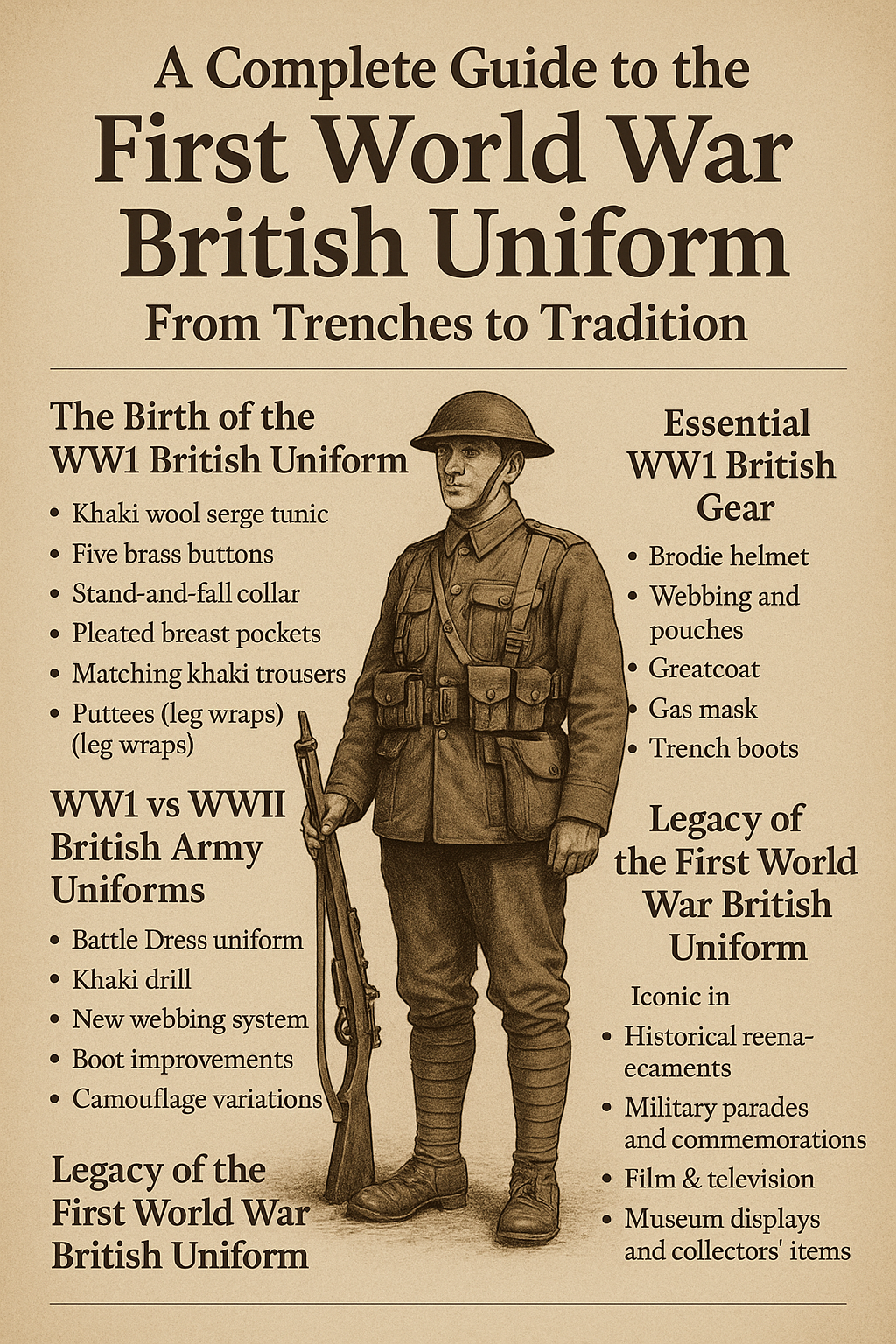
A Complete Guide to the First World War British Uniform: From Trenches to Tradition
Published on Jul 21, 2025
A Complete Guide to the First World War British Uniform: From Trenches to Tradition
The First World War was not only a defining moment in global history but also a significant milestone in the evolution of military uniforms. The First World War British uniform, often remembered for its practicality and iconic design, represents the resilience and resourcefulness of the British Army during one of the most challenging periods of the 20th century.
In this detailed guide, we’ll dive into:
- The design and functionality of the WW1 British uniform
- Its transition into the WWII British Army uniform
- How these uniforms shaped modern military dress
- Where to find authentic and reproduction uniforms for collectors and reenactors
The Birth of the WW1 British Uniform
When Britain entered the war in 1914, the military uniform was vastly different from its pre-war ceremonial versions. The British Expeditionary Force (BEF) needed practical, hard-wearing gear for trench warfare, leading to the creation of the Service Dress uniform.
Key features of the WW1 British uniform included:
- Khaki wool serge tunic: This replaced the colorful red coats of earlier centuries. Khaki provided camouflage and was more suitable for modern warfare.
- Five brass buttons: Stamped with the regimental insignia, these gave the uniform a distinct military identity.
- Stand-and-fall collar: Functional and formal, allowing use with or without a tie.
- Pleated breast pockets: For carrying field essentials like notebooks or rations.
- Matching khaki trousers: Straight-cut and practical for movement in muddy terrain.
- Puttees (leg wraps): Wrapped from the ankle to the knee for lower leg protection, they were a defining feature of WW1 soldiers.
The uniform was designed to be durable, practical, and uniform across ranks, setting a new standard in military outfitting.
Essential WW1 British Gear
The uniform alone was not enough. British soldiers in the First World War were also equipped with:
- Brodie helmet (introduced in 1915): Offering protection from shrapnel.
- Webbing and pouches: Carried ammunition, rations, water bottles, and entrenching tools.
- Greatcoat: A long wool coat issued for winter campaigns.
- Gas mask: An essential item from 1915 onwards due to chemical warfare.
- Trench boots: Designed for muddy and water-logged conditions.
All these elements worked together to create an efficient system of dress and utility for trench warfare.
Ranks, Regiments & Insignias
While the base uniform was standard, insignias and badges helped distinguish:
- Rank (e.g., private, sergeant, captain)
- Regiment (e.g., Royal Fusiliers, Highlanders)
- Special units like medics or artillery divisions
These insignias were typically sewn or pinned onto the tunic shoulders or sleeves and became essential for military identification.
WW1 vs WWII British Army Uniforms
The WWII British army uniform was an evolution rather than a complete redesign of its predecessor.
WWII Uniform Changes Included:
- Battle Dress uniform: Shorter tunic, bloused trousers, and a more modern cut
- Khaki Drill: A lighter uniform version for hot climates
- New webbing system: Improved carrying gear for weapons and supplies
- Boot improvements: Ankle boots replaced trench boots and puttees
- Camouflage variations: For specific missions (e.g., paratroopers)
While the WW1 British uniform prioritized utility in trench warfare, WWII uniforms reflected the more mobile and global nature of the conflict.
Legacy of the First World War British Uniform
Even today, the WW1 British uniform remains iconic in:
- Historical reenactments
- Military parades and commemorations
- Film and television (e.g., 1917, War Horse)
- Museum displays and collectors' items
Many modern military units around the world still adopt design cues from the British Service Dress—proof of its long-lasting impact.
Reproduction & Collectible British Uniforms
For collectors and reenactors, authenticity is key. That’s where Paddelaters.com excels.
Our curated collection includes:
- Authentic WW1 British uniforms and replicas
- WWII British Army uniforms
- Accessories and gear (e.g., Brodie helmets, webbing, trench coats)
- Custom sizing and tailoring
Whether you're participating in a living history event or expanding your military collection, our gear ensures quality and historical accuracy.
How to Spot Authentic WW1 British Uniforms
When evaluating a uniform or piece of equipment, check for:
- Original stitching and materials (wool serge, brass buttons)
- Manufacturing dates and regimental markings
- Government broad arrow stamp (on many official issue items)
- Signs of wear consistent with trench use
For new collectors, buying from trusted specialists like Paddelaters.com eliminates guesswork and ensures historical fidelity.
Conclusion
The First World War British uniform was more than just fabric and thread—it was a symbol of endurance, discipline, and identity in one of the most trying times in modern history. As warfare changed, so did the uniform, laying the groundwork for the WWII British army uniform and modern military attire.
Whether you’re a reenactor, historian, or passionate collector, understanding the significance and structure of the WW1 British uniform adds depth to any exploration of military heritage. And when it comes to sourcing authentic or reproduction uniforms, Paddelaters.com is your trusted ally in preserving this proud legacy.
